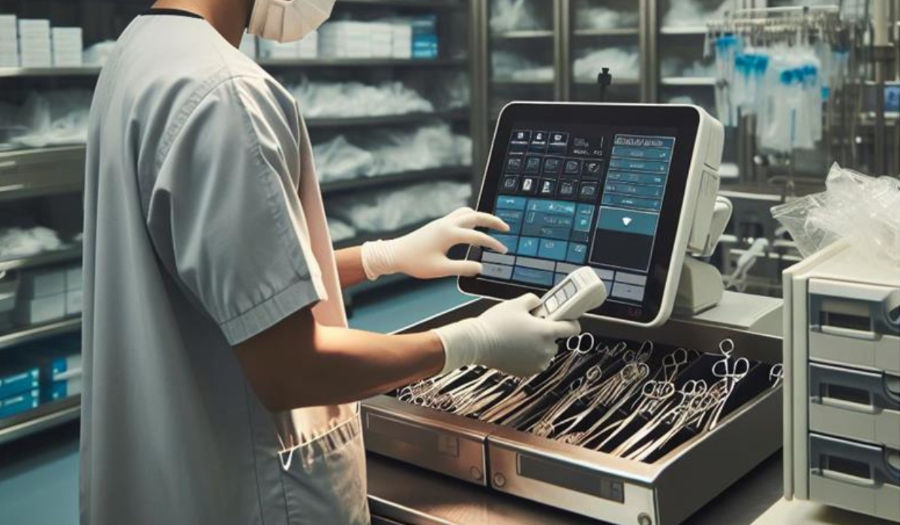Automation in CSSDs: Transforming Sterile Services Departments
- Matthew LeMasonry
- Apr 15
- 5 min read
Updated: Jul 15
Sterile Services Departments (SSDs) play a critical role in healthcare decontamination processes, ensuring patient safety through proper sterilisation of medical devices. Automation technologies are transforming these departments, bringing unprecedented efficiency and reliability to the three levels of decontamination required in modern healthcare settings. This article explores how these innovations are revolutionising traditional decontamination processes in hospitals across the UK, and how specialised project management can support successful implementation.
Understanding the Three Levels of Decontamination in Modern Sterile Services
The sterile service department ensures that all reusable medical devices undergo proper decontamination before patient use. This critical process follows three distinct levels:
Cleaning - Physical removal of contaminants and organic material
Disinfection - Reduction of viable microorganisms to safe levels
Sterilisation - Complete elimination of all microorganisms

In today's fast-paced healthcare environment, decontamination technicians face mounting pressure to increase throughput while maintaining rigorous compliance standards. Automation technologies address these challenges by enhancing each level of the decontamination process.
Key Automation Technologies in Hospital Decontamination Units
Modern hospital decontamination units are increasingly adopting automation technologies to transform sterile services operations. These systems support each stage of the instrument decontamination process while significantly improving safety and compliance.
Automated Cleaning Systems: First Stage Decontamination
Advanced washer-disinfectors represent a significant advancement in the initial phase of decontamination. These systems process surgical instruments with controlled parameters to ensure consistent cleaning results, even for complex devices with intricate channels and crevices.
Modern automated washers typically feature:
Ultrasonic technology that removes contaminants from hard-to-reach areas
Configurable cycle parameters based on instrument requirements
Documentation capabilities that create verifiable records of the decontamination process
Water quality monitoring to maintain optimal cleaning effectiveness
These systems help decontamination technicians achieve more standardised cleaning processes while reducing manual handling of contaminated instruments.
Material Transport Automation: Streamlining Decontamination Workflow
Workflow efficiency in sterile processing departments often depends on smooth movement of instruments between different zones. Automated conveyor systems and robotic handling solutions help maintain proper separation between contaminated and clean areas while reducing manual transport requirements.
These systems support unidirectional workflow through the decontamination unit, minimising cross-contamination risks and helping track instruments throughout the entire sterile processing cycle. Properly implemented transport automation can significantly reduce bottlenecks in the decontamination process.

Track and Trace Systems for Surgical Instrument Decontamination
Digital tracking technologies have transformed instrument management through the stages of decontamination. Using methods such as barcode scanning, RFID tagging, and laser-etched marking, these systems maintain complete visibility of each instrument from use through reprocessing.
Benefits include:
Real-time instrument location tracking
Automatic documentation of completed decontamination steps
Maintenance scheduling based on usage history
Enhanced compliance with regulatory requirements
Improved instrument availability and utilisation
These systems allow sterile services departments to verify that each instrument has completed all required decontamination processes before returning to service.

Automated Sterilisation Equipment for Final Decontamination
The final sterilisation phase now benefits from advanced automated systems that ensure consistent results.
Modern sterilisers feature:
Programmable cycles for different instrument categories
Continuous monitoring of critical parameters
Automated documentation of cycle data
Integration with tracking systems for complete process verification
These technologies support the critical final stage of decontamination by providing controlled sterilisation conditions with comprehensive monitoring and documentation.
Integrated Automation in the Decontamination Process
The most significant advancements come from integrating these various technologies into a cohesive decontamination system. Modern sterile services departments now implement connected workflows that link all stages of instrument processing—from receipt of contaminated items through cleaning, disinfection, sterilisation, and storage.
This integration enhances overall decontamination efficiency while providing complete documentation throughout the process.

Benefits of Automation in Sterile Services Departments
Enhanced Efficiency and Productivity
Automation in sterile services significantly increases operational efficiency compared to traditional methods. Manual decontamination processes are time-consuming and labour-intensive, often creating bottlenecks in hospital workflow. Automated systems process instruments more rapidly while maintaining consistent quality.
Quick Takeaway: Studies show automated decontamination can reduce processing time by 30-50% while handling increased instrument volumes.
Consistency and Reliability in Decontamination Process
Consistency in the decontamination of reusable medical devices is essential for patient safety. Automated systems standardise decontamination process steps, ensuring each instrument undergoes identical treatment. This standardisation proves particularly important in busy hospital sterile services departments where both volume and complexity of instruments continue to increase.
Improved Safety for Staff and Patients
Safety remains paramount in decontamination services. Automation reduces direct human contact with contaminated instruments, protecting decontamination technicians from potential exposure to hazardous materials. For patients, the precision of automated systems ensures thorough decontamination, reducing infection risks associated with inadequately processed instruments.
Cost-Effectiveness and Resource Optimisation
While the initial investment in automation technology for NHS sterile services departments can be substantial, the long-term benefits typically outweigh the costs:
Reduced labour costs
Minimised instrument damage
Optimised resource utilisation
Decreased instrument replacement costs
Many facilities report significant ROI through improved operational efficiency within 2-3 years of implementation.

Implementation Considerations for Decontamination Automation
Implementing automation in a hospital sterile services department requires careful planning and consideration of the existing sterile processing department layout. Key factors include:
Assessment of Current Workflows: Understanding existing decontamination process steps before introducing automation
Staff Training: Ensuring decontamination technicians receive comprehensive training on new technologies
Phased Implementation: Gradually introducing automation to minimise disruption to critical services
Validation Protocols: Establishing robust testing and validation procedures for automated systems
Integration with Existing Systems: Ensuring compatibility with hospital information systems and other technologies
The Future of Sterile Services and Decontamination Technology
The future of decontamination in sterile processing departments looks promising with continued technological advancements. Innovations include:
Artificial Intelligence for predictive maintenance and process optimisation
Advanced Robotics for more complex instrument handling and processing
Real-time Monitoring Systems providing comprehensive analytics on decontamination effectiveness
Sustainable Technologies reducing water and energy consumption in sterile processing equipment
These innovations will further transform how CSSD departments in hospitals operate, making decontamination services more efficient, reliable, and cost-effective.

Conclusion
Automation is revolutionising decontamination services in healthcare facilities across the UK. By improving efficiency, consistency, safety, and cost-effectiveness in the sterile services department, automated systems enable healthcare institutions to meet increasing demands while maintaining the highest standards of patient care. While implementing these technologies presents certain challenges, the benefits make automation an essential consideration for any hospital sterile services department seeking to optimise its operations.
For healthcare facilities planning to modernise their decontamination processes, our specialised project management team can ensure successful implementation with minimal disruption.
Contact us today for a complimentary assessment of your sterile services department automation potential.



